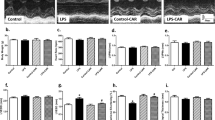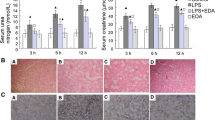Abstract
Myocardial dysfunction, a major component of sepsis-induced multiorgan failure, contributes to the production of massive amounts of pro-inflammatory cytokines. Nitric oxide (NO) is known to act as a precursor of free radicals in inflammation. This research was conducted to assess the effect of aminoguanidine (AG) on lipopolysaccharide (LPS)-induced heart injury. 50 male rats were categorized into five groups (n = 10): (1) control, (2) LPS, (3) LPS-AG50, (4) LPS-AG100, and (5) LPS-AG150. LPS (1 mg/kg) was injected for 5 weeks, and AG (50, 100 and 150 mg/kg) was injected 30 min prior to LPS administration. All drugs were injected intraperitoneally. LPS-evolved cardiovascular toxicity was indicated by the augmentation in the level of nitric oxide (NO) metabolites, interleukin (IL)-6 and malondialdehyde (MDA), as well as reduced contents of total thiol groups, catalase (CAT), and superoxide dismutase (SOD) activity in serum, heart, and aortic tissues. In AG treated groups, noxious effects of LPS were not observed in the serum and harvested tissues. AG reduced MDA, NO metabolites, and IL- 6 and increased total thiol, CAT, and SOD activity in the heart, aorta and serum. As an inhibitor of inducible NO synthase (iNOS), AG further reduced LPS-induced oxidative stress and inflammation, hence considered as cardioprotective.



Similar content being viewed by others
References
Klein, I., & Ojamaa, K. (2001). Thyroid hormone-targeting the heart. Endocrinology, 142(1), 11–12.
Aderem, A., & Ulevitch, R. J. (2000). Toll-like receptors in the induction of the innate immune response. Nature, 406(6797), 782–787.
Ben-Shaul, V., Sofer, Y., Bergman, M., Zurovsky, Y., & Grossman, S. (1999). Lipopolysaccharide-induced oxidative stress in the liver: comparison between rat and rabbit. Shock, 12(4), 288–293.
Beutler, B., & Rietschel, E. T. (2003). Innate immune sensing and its roots: the story of endotoxin. Nature Reviews Immunology, 3(2), 169–176.
Hansson, G. K. (2005). Inflammation, atherosclerosis, and coronary artery disease. New England Journal of Medicine, 352(16), 1685–1695.
Akira, S., Takeda, K., & Kaisho, T. (2001). Toll-like receptors: critical proteins linking innate and acquired immunity. Nature Immunology, 2(8), 675.
Bonizzi, G., & Karin, M. (2004). The two NF-κB activation pathways and their role in innate and adaptive immunity. Trends in Immunology, 25(6), 280–288.
Yoon, H. J., Moon, M. E., Park, H. S., Im, S. Y., & Kim, Y. H. (2007). Chitosan oligosaccharide (COS) inhibits LPS-induced inflammatory effects in RAW 264.7 macrophage cells. Biochemical and Biophysical Research Communications, 358(3), 954–959.
Park, J.-Y., Park, C.-M., Kim, J.-J., Noh, K.-H., Cho, C.-W., & Song, Y.-S. (2007). The protective effect of chlorophyll a against oxidative stress and inflammatory processes in LPS-stimulated macrophages. Food Science Biotechnology, 16, 205–211.
Sebai, H., Sani, M., Aouani, E., & Ghanem-Boughanmi, N. (2011). Cardioprotective effect of resveratrol on lipopolysaccharide-induced oxidative stress in rat. Drug and Chemical Toxicology, 34(2), 146–150.
Mohebbati, R., Anaeigoudari, A., & Khazdair, M. (2017). The effects of Curcuma longa and curcumin on reproductive systems. Endocrine Regulations, 51(4), 220–228.
Anaeigoudari, A., Soukhtanloo, M., Reisi, P., Beheshti, F., & Hosseini, M. (2016). Inducible nitric oxide inhibitor aminoguanidine, ameliorates deleterious effects of lipopolysaccharide on memory and long term potentiation in rat. Life Sciences, 158, 22–30.
Rodrigues, L., Biasibetti, R., Swarowsky, A., Leite, M. C., Quincozes-Santos, A., Quilfeldt, J. A., et al. (2009). Hippocampal alterations in rats submitted to streptozotocin-induced dementia model are prevented by aminoguanidine. Journal of Alzheimer’s Disease, 17(1), 193–202.
Díaz, A., Rojas, K., Espinosa, B., Chávez, R., Zenteno, E., Limón, D., et al. (2014). Aminoguanidine treatment ameliorates inflammatory responses and memory impairment induced by amyloid-beta 25–35 injection in rats. Neuropeptides, 48(3), 153–159.
Saadat, S., Beheshti, F., Askari, V. R., Hosseini, M., Mohamadian Roshan, N., & Boskabady, M. H. (2019). Aminoguanidine affects systemic and lung inflammation induced by lipopolysaccharide in rats. Respiratory Research, 20(1), 96.
Barmaki, B., & Khazaei, M. (2015). Effect of aminoguanidine on cardiovascular responses and survival time during blood loss: A study in normotensive and deoxycorticosterone acetate-salt hypertensive rats. International Journal of Applied and Basic Medical Research, 5(1), 12–17.
Chan, V., Hoey, A., & Brown, L. (2006). Improved cardiovascular function with aminoguanidine in DOCA-salt hypertensive rats. British Journal of Pharmacology, 148(7), 902–908.
Oak, J. H., Youn, J. Y., & Cai, H. (2009). Aminoguanidine inhibits aortic hydrogen peroxide production, VSMC NOX activity and hypercontractility in diabetic mice. Cardiovascular Diabetology, 8, 65.
Beheshti, F., Hosseini, M., Shafei, M. N., Soukhtanloo, M., Ghasemi, S., Vafaee, F., et al. (2017). The effects of Nigella sativa extract on hypothyroidism-associated learning and memory impairment during neonatal and juvenile growth in rats. Nutritional Neuroscience, 20(1), 49–59.
Mahmoudabady, M., Lashkari, M., Niazmand, S., & Soukhtanloo, M. (2017). Cardioprotective effects of Achillea wilhelmsii on the isolated rat heart in ischemia-reperfusion. Journal of Traditional and Complementary Medicine, 7(4), 501–507.
Habeeb, A. F. (1972). Reaction of protein sulfhydryl groups with Ellman's reagent. Methods in Enzymology, 25, 457–464.
Madesh, M., & Balasubramanian, K. A. (1997). A microtiter plate assay for superoxide using MTT reduction method. Indian Journal of Biochemistry & Biophysics, 34(6), 535–539.
Aebi, H. (1984). Catalase in vitro. Methods in Enzymology, 105, 121–126.
Kushner, I. (1982). The phenomenon of the acute phase response. Annals of the New York Academy of Sciences, 389(1), 39–48.
Chen, L., Deng, H., Cui, H., Fang, J., Zuo, Z., Deng, J., et al. (2018). Inflammatory responses and inflammation-associated diseases in organs. Oncotarget, 9(6), 7204.
Won, K., Campos, S. P., & Baumann, H. (1993). Experimental systems for studying hepatic acute phase response (pp. 255–271). Boca Raton, FL: CRC Press Inc.
Galanos, C., Freudenberg, M. A., & Reutter, W. (1979). Galactosamine-induced sensitization to the lethal effects of endotoxin. Proceedings of the National Academy of Sciences, 76(11), 5939–5943.
Beutler, B., Milsark, I., & Cerami, A. (1985). Passive immunization against cachectin-tumor necrosis factor protects mice from lethal effect of endotoxin. Science, 229, 869–872.
Gershenwald, J. E., Fong, Y., Fahey, T. J., Calvano, S. E., Chizzonite, R., Kilian, P. L., et al. (1990). Interleukin 1 receptor blockade attenuates the host inflammatory response. Proceedings of the National Academy of Sciences, 87(13), 4966–4970.
Oldenburg, H. S., Rogy, M. A., Lazarus, D. D., van Zee, K. J., Keeler, B. P., Chizzonite, R. A., et al. (1993). Cachexia and the acute-phase protein response in inflammation are regulated by interleukin-6. European Journal of Immunology, 23(8), 1889–1894.
Giralt, M., Gasull, T., Blanquez, A., & Hidalgo, J. (1993). Effect of endotoxin on rat serum, lung and liver lipid peroxidation and on tissue metallothionein levels. Revista Espanola de Fisiologia, 49(2), 73–78.
Anaeigoudari, A., Soukhtanloo, M., Shafei, M. N., Sadeghnia, H. R., Reisi, P., Beheshti, F., et al. (2016). Neuronal nitric oxide synthase has a role in the detrimental effects of lipopolysaccharide on spatial memory and synaptic plasticity in rats. Pharmacological Reports, 68(2), 243–249.
Hafez, H. M., Ibrahim, M. A., Ibrahim, S. A., Amin, E. F., Goma, W., & Abdelrahman, A. M. (2015). Potential protective effect of etanercept and aminoguanidine in methotrexate-induced hepatotoxicity and nephrotoxicity in rats. European Journal of Pharmacology, 768, 1–12.
Diaz, A., Limon, D., Chávez, R., Zenteno, E., & Guevara, J. (2012). Aβ 25–35 Injection into the Temporal Cortex Induces Chronic Inflammation that Contributes to Neurodegeneration and Spatial Memory Impairment in Rats. Journal of Alzheimer's Disease, 30(3), 505–522.
Paola, R., Mazzon, E., Muia, C., Crisafulli, C., Terrana, D., Greco, S., et al. (2007). Effects of etanercept, a tumour necrosis factor-α antagonist, in an experimental model of periodontitis in rats. British Journal of Pharmacology, 150(3), 286–297.
Takizawa, Y., Kitazato, T., Ishizaka, H., Kamiya, N., Tomita, M., & Hayashi, M. (2011). Effect of aminoguanidine on ischemia/reperfusion injury in rat small intestine. Biological and Pharmaceutical Bulletin, 34(11), 1737–1743.
Ahmed, A. F., Mahmoud, M. F., Ouf, M. A., & El-Fathaah, E. A. (2011). Aminoguanidine potentiates the hepatoprotective effect of silymarin in CCL4 treated rats. Annals of Hepatology, 10(2), 207–215.
Atasayar, S., Gürer-Orhan, H., Orhan, H., Gürel, B., Girgin, G., & Özgüneş, H. (2009). Preventive effect of aminoguanidine compared to vitamin E and C on cisplatin-induced nephrotoxicity in rats. Experimental and Toxicologic Pathology, 61(1), 23–32.
Eroglu, C., Yildiz, O. G., & Soyuer, S. (2008). Aminoguanidine ameliorates radiation-induced oxidative lung damage in rats. Clinical and Investigative Medicine, 31(4), E182.
Olas, B., Nowak, P., & Wachowicz, B. (2004). Resveratrol protects against peroxynitrite-induced thiol oxidation in blood platelets. Cellular & Molecular Biology Letters, 9(4A), 577–587.
Reinartz, M., Ding, Z., Flögel, U., Gödecke, A., & Schrader, J. (2008). Nitrosative stress leads to protein glutathiolation, increased s-nitrosation, and up-regulation of peroxiredoxins in the heart. Journal of Biological Chemistry, 283(25), 17440–17449.
Abraham, P., & Rabi, S. (2011). Protective effect of aminoguanidine against cyclophosphamide-induced oxidative stress and renal damage in rats. Redox Report, 16(1), 8–14.
Acknowledgements
The authors would like to thank the Vice Presidency for the Research Department of Mashhad University of Medical Sciences for their financial support (Grant Number 961380).
Author information
Authors and Affiliations
Corresponding author
Ethics declarations
Conflict of interest
The authors declare that they have no conflicts of interest.
Ethical Approval
All experiments were conducted in accordance with the Animal Experimentation Ethics Committee of MUMS (Approval No. IR.MUMS.fm.REC.1397.35).
Additional information
Communicated by Y. James Kang.
Publisher's Note
Springer Nature remains neutral with regard to jurisdictional claims in published maps and institutional affiliations.
Rights and permissions
About this article
Cite this article
Beheshti, F., Hosseini, M., Hashemzehi, M. et al. The Cardioprotective Effects of Aminoguanidine on Lipopolysaccharide Induced Inflammation in Rats. Cardiovasc Toxicol 20, 474–481 (2020). https://doi.org/10.1007/s12012-020-09570-w
Published:
Issue Date:
DOI: https://doi.org/10.1007/s12012-020-09570-w




